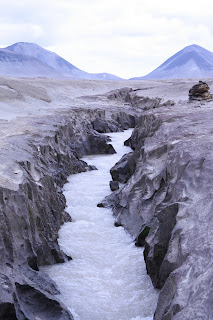Welcome to the second of my three posts on my Katmai trip. After completing my work on Wednesday and Thursday, I took a long weekend and headed for the Valley of Ten Thousand Smokes (http://www.nps.gov/katm/planyourvisit/loader.cfm?csModule=security/getfile&PageID=305031). On June 6, 1912 a volcano on the Alaska Peninsula erupted. A total of four eruptions displaced more than 7 cubic miles of earthen matter into the air and the nearby valley. Once known as the Ukak valley, it was soon covered in tephra (volcanic matter). Waters trapped underneath were heated into steam, which broke through the tephra. Consequently, Robert Griggs of the USGS called it the Valley of Ten Thousand Smokes.
This is a view of the valley from the vicinity of the trail head. I took a bus 23 miles from Brooks Camp to the trail head on Friday morning. The other riders were taking the bus out to the visitor center where they would have lunch and then join a ranger for a short 2 hour hike. I disembarked the bus at 11 a.m. and headed out into the volcanic wilderness.
As I mentioned earlier the volcano exploded four times. One of those explosions actually emptied andesite lava from underneath an adjacent volcano combing different types of rock. Disclaimer: I am not a geologist, but I believe this is a heterogeneous composition of ryolite and andesite which would have come from the third explosion.
My most exciting find! This is a piece of ryolite. The pumice from the first explosion was described as a snow white ryolite pumice. This is the only piece I saw during my 40 miles of trekking through the valley.
My hike on Friday consisted of a 14 mile walk out to Baked Mountain. I crossed this river (at a different) spot about an hour after I began. All of the reddish colored soil is volcanic deposit. 99 years later, the Lethe River has cut its way across the valley again. The water is glacier fed and thus very cold and it is also quite swift.
The mineralization of the rocks and soil around me were amazing. Unfortunately, I do not have the space or time to share all of these pictures. I do not know for certain, but I think this may be a location of one of the ten thousand smokes, a place where steam broke through the volcanic matter to escape from the surface of the valley.
This is baked mountain with an elevation a little over 3800 feet, but look closely. The purplish material toward your viewing right is indeed rock, but that tan-ish stuff is finely ground tephra. Have you ever walked on the sand on the beach? Now, consider what it would be like trying to hike 700 feet vertical on that terrain. However, before I could even consider that, I had to deal with the Lethe River.
The Lethe River is not particularly large, but it is swift. The width along here is about 10-12 feet and the depth is only about 4 feet. However, when I placed a sturdy hiking staff into the current to test the depth, it was so swift that I could barely hold the staff vertical with single hand. I walked up and down the south (right) side of the river for over half an hour trying to find a spot to cross. I found a few short sports where I could climb down one side and climb back up the other, but inevitably, they current was too fast to attempt a crossing. Some fools might be tempted to vault the river with a quick jump. Even for those who could jump ten feet, could it be done with 40 pounds of gear? If you slip on a wet rock on the landing you would been in the water. The danger of the Lethe River comes not from its depth but the combination of the swift and cold current; hikers have died crossing this river, but not I.
Unable to find a crossing (above) I kept moving. Nearing 5 p.m. I began to consider camping for the night, because I estimated that the cabins on Baked Mountain would be at least two hours from the river crossing. Suddenly, I discovered this large pool with gentle ripples. I crossed the Lethe River at the widest spot with a depth of about 12 inches and a very passive current.
In the background you will see Mt. Griggs under clouds. The foreground is the slopes of Baked Mountain. My body sank into the tephra with each and every step up. I was stepping up as quickly as I would sprint on solid ground. With an additional 40 pounds on my back, this challenge was enough to force me to rest every 60-70 steps. It took me over an hour climb 700 feet vertically. I think I covered 1/4 - 1/2 mile horizontally in that time.
Paradise! At 7:12 p.m., I crested the lower spine of Baked Mountain and found the huts. I probably could have walked around the mountain with greater ease, but in hindsight climbing over it was a great accomplishment. These huts were created by the University of Oregon research team in the 1960s when they conducted scientific research in the valley. They offered great protection from the wind and a flat plywood bed never felt so good!










No comments:
Post a Comment